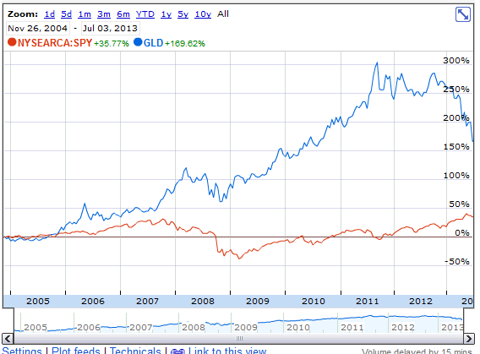Although not perfect (nothing is), gold has a tendency to go up in the face of external shocks…[and] tends to have a low and sometimes negative correlation to US equities. As such, with stocks up, gold being down is not a terrible outcome for the investor using gold as a diversifier. Let me explain further below.
shocks…[and] tends to have a low and sometimes negative correlation to US equities. As such, with stocks up, gold being down is not a terrible outcome for the investor using gold as a diversifier. Let me explain further below.
So writes Roger Nusbaum (www.randomroger.blogspot.ca) in edited excerpts from his original article* entitled Understanding the Drop in Gold.
[The following article is presented by Lorimer Wilson, editor of www.munKNEE.com and may have been edited ([ ]), abridged (…) and/or reformatted (some sub-titles and bold/italics emphases) for the sake of clarity and brevity to ensure a fast and easy read. This paragraph must be included in any article re-posting to avoid copyright infringement.]
Nusbaum goes on to say in further edited excerpts:
Over the years I have been consistent in believing that low to mid single digit exposure is enough to have the effect of being a diversifier…If equities are going up and your diversifier-sized position in gold is going down that is ok. If everything you own goes up together then you should expect it to go down together and in that case you really aren’t very well diversified.
If you look at the chart above comparing a client holding GLD and SPY I think you see that gold does what it is supposed to more often than not. For much of the last decade stocks were not making much progress and gold went quite a bit higher. In late 2007 and into the first few months of 2008 there was a negative correlation. Starting in March 2009 everything went up for a while. Then in this down move for gold equities have gone straight up, so again a negative correlation, which is what people expect during moments of clarity.
Conclusion
Stocks up, gold down is not a terrible outcome for the investor using gold as a diversifier. Of course, it is up to each individual to decide whether, after accounting for all the pluses and minuses of a position in gold, it is still worth owning, but stocks up gold down is not a shocking market behavior.
[Editor’s Note: The author’s views and conclusions in the above article are unaltered and no personal comments have been included to maintain the integrity of the original post. Furthermore, the views, conclusions and any recommendations offered in this article are not to be construed as an endorsement of such by the editor.]
*http://randomroger.blogspot.ca/2013/07/understanding-drop-in-gold.html (Random Roger © 2009)
Related Articles:
1. Physical Gold and Gold Stocks Should be in Your Portfolio – Here’s Why
Do you own enough gold and silver for what lies ahead? If 10% of your total investable assets (i.e., excluding equity in your primary residence) aren’t held in various forms of gold and silver, we…think your portfolio is at risk. Here’s why. Words: 625
2. Don’t Laugh – Invest At Least 65% of Your Portfolio In Precious Metals!
There is such a “fear of gold” amongst most people that it must be due to statist indoctrination and propaganda because it makes no rational sense to have such a fear of such a time tested and true store of wealth. After all, we are talking about time tested and true money – the only money that has lasted for thousands of years and is still fully accepted worldwide as a store of wealth….What would you rather hold “for eternity” gold [or] US dollars [which are nothing more than] a paper debt obligation of a bankrupt nation state? Words: 450
3. Your Portfolio Isn’t Adequately Diversified Without 7-15% in Precious Metals – Here’s Why
The traditional view of portfolio management is that three asset classes, stocks, bonds and cash, are sufficient to achieve diversification. This view is, quite simply, wrong because over the past 10 years gold, silver and platinum have singularly outperformed virtually all major widely accepted investment indexes. Precious metals should be considered an independent asset class and an allocation to precious metals, as the most uncorrelated asset group, is essential for proper portfolio diversification. [Let me explain.] Words: 2137
4. It is Imperative to Invest in Physical Gold and/or Silver NOW – Here’s Why
Asset allocation is one of the most crucial aspects of building a diversified and sustainable portfolio that not only preserves and grows wealth, but also weathers the twists and turns that ever-changing market conditions can throw at it. However, while the average [financial] advisor or investor spends a great deal of time carefully analyzing and picking the right stocks or sectors, the basic and primary task of asset allocation is often overlooked. [According to research by both Wainwright Economics and Ibbotson Associates and the current Dow:gold ratio, allocating a portion of one’s portfolio to gold and/or silver and/or platinum is imperative to protect and grow one’s financial assets. Let me explain.] Words: 1060
5. Protect Your Portfolio By Including 15% Gold Bullion – Here’s Why
We are reading a lot of hype these days about gold and the necessity to own it but only about 2% of ‘investors’ actually have gold in their portfolios and those that have done so have insufficient quantities to offset the future impact of inflation and to maximize their portfolio returns. New research, however, has determined a specific percentage to accomplish such objectives. Words: 1063
6. Believe It or Not: Only 1 Fund Has Outperformed Physical Gold Since 2007!
Out of the 7,500 separate mutual funds available, and with 22,000 shares classes to choose from, only 1 fund – just ONE fund – actually managed to achieve a greater percentage return than gold bullion since the alarm bells rang out at the turn of 2007! [That being said, are you still one of the 99% of investors who, for whatever reason (are you foolishly listening to the “advice” provided by your stock broker/securities salesman going under the guise of a financial “advisor”), is still without any physical gold or silver?] Words: 395
 munKNEE.com Your Key to Making Money
munKNEE.com Your Key to Making Money



